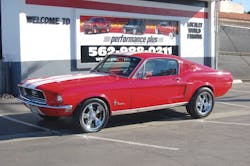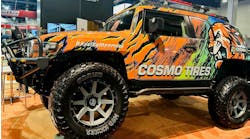The domestic ultra-high performance replacement market has grown 900% since 1994, according to Modern Tire Dealer research. 900%! In addition, the number of UHP tire units shipped has increased every year.
Those are nationwide figures. Are tire dealers, especially the one-store operators, experiencing the same growth in their stores? To find out, we asked them about this dynamic market segment, and how they go about selling UHP tires and wheels. Their answers may surprise you.
“Replacement UHP tire sales are up because of OE,” says Freddie Rine, a salesperson at Stoney Hollow Tire, a wholesale operation in Martins Ferry, Ohio. “It’s what the manufacturers are building and it’s what the cars are coming with.”
“The economy still isn’t totally back yet, and it’s getting tougher to sell UHP tires,” says Joy Kokaisel, president of Norm’s Tire Sales in Roseville, Minn., a family-owned business with one retail location. “We are seeing more nice wheels coming out at the OE level, and consumers don’t replace wheels. However, they do replace their UHP tires when they wear out.”
UHP demographics
Kokaisel says her most popular selling UHP brand at Norm’s Tire Sales is Michelin. She describes her UHP customers as baby boomers who are “middle aged, mid-life crisis-type people who have some disposable income.”
Being situated between St. Paul and Minneapolis, Norm’s Tire Sales has a large metro area from which to draw customers. “We are part of the ACCC buying group and we have promotions through them. We also have a Facebook page where we post rebates and photos of street rods, which helps our UHP tire and wheel sales.”
Ed Whitehead, president of Ed Whitehead’s Tire Pros, Yuma, Ariz., says his four-store operation has good UHP tire sales because his market has a lot of consumers who drive BMWs and other vehicles that come with UHP tires as original equipment.
“Of our passenger tire sales, about 15% to 20% are UHP tires,” he says. “UHP at OE is why we’re selling more UHP tires. We replace them with something as good or better.”
[PAGEBREAK]
All four of Whitehead’s stores are retail and commercial, and he is a member of the Independent Tire Dealers Group.
“For some of our co-members in California, UHP is a bigger part of their market because the ratio of that kind of car is much bigger in an area like Los Angeles or Newport Beach. More people have money to buy more expensive cars that have UHP fitments on them.”
“The customers for UHP tire and wheel packages are more youthful and status-oriented people,” says Hank Feldman, president of Performance Plus Tire & Automotive in Long Beach, Calif. “On the tire side alone, we do draw from a broad market area. We have brands like Pirelli that some customers might not be able to find in their local area.
“Our pricing typically matches most Web prices. We’ll see a customer drive 30 to 40 miles to buy a set of $1,500 Michelin Pilot Sports or Continental CrossContacts.”
Tire price is driven more by the wheels because many consumers “are really trying to fit into a budget,” says Feldman. “They want the wheels and need the tires.”
Stoney Hollow’s Rine agrees. “Sometimes consumers are looking for a low-end import UHP tire that’s cheap because they’re spending a couple thousand dollars for the wheels. They’re not buying the good Bridgestone, Goodyear or Michelin brands. They’re putting on less expensive tires when buying nice wheels.”
Web influence grows
“It’s really tough to compete with the Internet,” says Kokaisel. “We don’t put prices on our website because no matter what, with Internet competition, we’re never going to be the lowest. People call us or email us to get prices, and then we can explain what additional services we offer.”
Those services include buffing a customer’s rims when they buy tires (and they take a beating in the Minnesota winters), and free mounting and balancing, with a Hunter RoadForce balancer. “Those are services they can’t get from a website.”
It’s easy for customers to get confusing information online, says Stoney Hollow’s Rine. “A lot of people don’t know enough about what they’re doing to order the right stuff. They’re shopping and getting part numbers and saying, ‘I like this wheel.’ Then they go to a shop and say, ‘Is this for me?’ They get the price online, too, and the dealers have to match the prices.”
Feldman uses the Internet to sell tires and wheels, and says this segment of his business is growing and will probably overcome the retail business in the next year or two in terms of volume.
“The Web continues to be a growth engine, and it’s really setting the bar on where the pricing is in the market. People who aren’t comfortable buying on the Web are using it as a shopping tool and then walking in to our retail store with what they found, saying, ‘OK, can you match the price?’ and we make the sale.”
[PAGEBREAK]
A bright UHP future?
“The UHP replacement tire market is still going to be around in the future,” says Rine. “It’s probably leveling off. There was a boom on it a few years ago but I think that’s pretty much dried up.”
“I think it’s going to continue to grow slowly until the economy improves,” says Feldman.
“We don’t get to pick the product that the customers want to buy, or the prices out there,” says Kokaisel. “We have to win them over with service and build our business based on that. That’s certainly driving UHP business.” ■
Consumer Reports rates ultra-high performance tires: And the No. 1 brands are... Pirelli and Michelin
The annual Consumer Reports (CR) tire test results came out in August 2013, and once again, Michelin ranks highly.
This year, CR tested 49 models of UHP summer, UHP all-season and performance winter tires. CR put the tires through a series of tests, including braking and handling on dry and wet pavement, resistance to hydroplaning, and grip on snow and, for all-season and winter tires, icy surfaces. CR also measured rolling resistance, and rated summer and all-season tires on tread life.
Based on the testing, CR assigned a score to each tire tested. Here is a list of CR’s recommended tires in the UHP categories, followed by each tire’s score.
UHP summer tires:
1. Pirelli P Zero, 78.
2. Michelin Pilot Super Sport, 78.
3. Yokohama Advan Sport V105, 76.
4. Nokian zLine, 76.
5. Continental ExtremeContact DW, 76.
6. Goodyear Eagle F1 Asymmetric 2, 74.
7. Vredestein Ultrac Vorti, 72.
UHP all-season tires:
1. Michelin Pilot port A/S 3, 76.
2. Goodyear Eagle F1 Asymmetric All-Season, 70.
3. Hankook Ventus S1 noble 2, 66.
4. Pirelli P Zero Nero All-Season, 64.
5. Cooper Zeon RS3-A, 64.
Here are brief summaries of the test results.
UHP summer tires: The Pirelli P Zero and the Michelin Pilot Super Sport came out on top among 21 tires in the category. The P Zero received excellent ratings for dry braking and handling. Top-rated in CR’s last test cycle, the Pilot Super Sport continues to perform well with its precise handling on dry and wet surfaces. It offers the best tread life of any summer tire CR tested.
UHP all-season tires: The Michelin Pilot Sport A/S 3 stands out among the 21 models of all-season tires — and many of the hard-core summer tires — for its dry braking and handling. Some other all-season tires have longer tread life, but the Michelin still achieves a very good rating here. The Goodyear Eagle F1 Asymmetric All-Season came in second with slightly lower dry braking and handling, but strong handling and long tread life.
Performance winter: Although not necessarily considered UHP tires, the winners in this category were the Nokian WR G3, Michelin Pilot Alpin PA4 and Nokian Hakkapeliitta R2. They finished with 66, 66 and 64 points, respectively.



